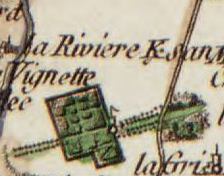K with diagonal stroke
Appearance

K with diagonal stroke (Ꝃ, ꝃ) is a letter of the Latin alphabet, derived from K with the addition of a diagonal bar through the leg.
Usage
This letter is used in medieval texts as an abbreviation for kalendas, calends, as well as for karta and kartam, a document or writ.[1][2] The same function could also be performed by "K with stroke" (Ꝁ, ꝁ), or "K with stroke and diagonal stroke" (Ꝅ, ꝅ).[1]
In the Breton language, this letter is used, mainly from the fifteenth to the twentieth century, to abbreviate Ker.[3]
-
Tomb of Louis-Marie-Gabriel Le Coat de Kerveguen
-
Kersan river
-
Menhir of Kerluhir
-
Ker Hermine
Computer encodings
Capital and small K with diagonal stroke is encoded in Unicode as of version 5.1, at codepoints U+A742 and U+A743.[4][5]
References
- ^ a b "Proposal to add medievalist characters to the UCS" (PDF). 30 January 2006. International Organization for Standardization. Archived from the original (PDF) on 16 July 2011. Retrieved 2 March 2017.
- ^ Cappelli, Lexicon Abbreviaturarum, p. 195.
- ^ Andries, Patrick (2003-03-25). "Entretien avec Ken Whistler, directeur technique du consortium Unicode". Document Numérique (in French). 6 (3–4): 329–351. doi:10.3166/dn.6.3-4.329-351. ISSN 1279-5127.
- ^ "Unicode Character 'LATIN CAPITAL LETTER K WITH DIAGONAL STROKE' (U+A742)". Fileformat.info. Retrieved 2 March 2018.
- ^ "Unicode Character 'LATIN SMALL LETTER K WITH DIAGONAL STROKE' (U+A743)". Fileformat.info. Retrieved 2 March 2018.
Bibliography
- Adriano Cappelli, Lexicon Abbreviaturarum, J. J. Weber, Leipzig (1928).




